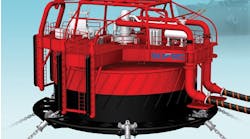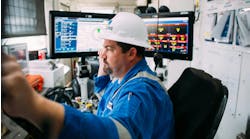Donald P. Fusilli Jr., The Telum Group
Four barrels or so had spilled from a corroded pipeline pumping oil from Prudhoe Bay, Alaska. Not all that much to get worried about, really. But from that little acorn sprouted - or should we say spurted - the largest spill ever on Alaska’s North Slope.
Four barrels? That was only 0.001% of the 400,000 barrels of oil carried by that pipeline every day. But it turned out to be huge when placed into the context of a larger issue - the need for better foresight, planning, and active execution of long-term maintenance.
Offshore maintenance, modifications, and operations (MMO) will see continuing steady growth, according to Douglas-Westwood. The analyst cites a future of high oil and gas prices, massive amounts of existing aging infrastructure, and growing technical complexity of field developments as reasons for the growth in MMO. Source: The World Offshore Oil & Gas Production & Spend Forecast 2007-2011 - Douglas-Westwood & Energyfiles.
What’s worse, this issue has become a challenge among many US companies and government agencies. And it is an issue that engineers have a special ability to identify and to help address.
Think of it this way. Everybody loves a good ribbon-cutting ceremony. The road is in perfect condition, no cracks or potholes, all signage is clear and well-lighted, and the landscaping looks beautiful. But nobody’s draping red-white-and-blue bunting or making speeches when the guard rails rust away or the concrete on an overpass crumbles and falls onto the roadway below. But that’s part of the deal, as well - a roadway has to survive to serve its purpose.
Engineers have the capacity to keep these long-range considerations in focus - long before they blossom into full-blown issues. It’s the old adage of being proactive, not reactive, to ensure long-term success. The oil and gas industry can benefit by taking a more aggressive and consistent approach to providing solid up-front design that includes comprehensive consideration of operations and maintenance practices and procedures.
BP might agree with that sentiment today very strongly, after the Prudhoe Bay oil spill problems, which sprang from corrosion in the lines. BP America President and Chairman Robert Malone told Fortune magazine that, “Normally smart pigging identifies inclusions or corrosion spots and then you come back with UT (ultrasonic) technology later. UT is the highest level of assurance that you can get - much more accurate than pigging. Now we know there is a gap, and pigging will become part of our procedures.”
While that plan should help avoid similar problems in the future, the Prudhoe Bay event nonetheless may be the most striking and close-to-home illustration of what can happen when long-term maintenance and operations are not standard procedure from the earliest phases of a project.
Infrastructure is not meant to be built once and expected to last forever. Bridges have an expected life span of 50 to 60 years. The national interstate highway system just marked its 50th anniversary. Similarly, oil and gas asset investors are taking a closer look at offshore platforms built in the 1950s, recognizing them as a growing asset for exploration and production.
Incorporating long-term maintenance and operations into the original project planning and engineering design process can give infrastructure owners and operators a leg up, ensuring top-tier functioning of these facilities right from the start.
Essentially, a Program Management - or lifecycle - approach is needed from beginning to end. The maintenance and operations strategies must be linked, and should start at the design phase by identifying materials, equipment, replacement parts, and other operating features, then defining the appropriate process and procedures to be implemented from the start. This will allow the recruiting, training, and managing of technical personnel and inspection staff to be aligned along similar standards of performance.
More dollars are committed today toward maintaining infrastructure than what it cost to build it in the first place. This holds especially true across the older infrastructure found offshore. Existing assets worldwide include 6,000 fixed platforms, 184 floating production units, 175,000 km (108,740 mi) of pipeline, 2,900 active subsea wells, and 650 offshore drilling units, according to Douglas-Westwood statistics.
Safety and regulatory compliance enter the mix, too. When it comes to long-term maintenance and operations, it’s easy to think about physical assets, but people are always the most important element. A litmus test for successful long-term approach may be to ask your organization the simple question: How do we operate safely, so that MMS, OSHA, or MSHA becomes a promoter for us?
Another issue, regulatory compliance, also should be incorporated into the planning and design phase by recruiting and training people aligned with achieving this goal, from the earliest discussions surrounding a project. And, of course, none of this happens without funding, so the budgeting process always has to be a part of the long-term maintenance and operations picture.
Why is this so important today? Because the world has changed in radically new ways - especially for the energy industry. Demand today for oil and gas has doubled based on rapid development in China, India, and other developing nations. Energy producers are putting in new facilities and supporting infrastructures to meet this explosive growth demand. These facts reinforce the importance of having a total, long-range game plan that must be followed religiously.
In a perfect world, oil and gas producers would always operate faster, better, cheaper, greener, and safer. Of course, that’s easier said than done, and not just among energy producers. The response to Hurricane Katrina remains the strongest example of how not to do this. The US Army Corps of Engineers, along with agencies at the federal, state, and local levels are still trying to plan a successful response strategy along these lines.
Truth is, a long-term maintenance and operations plan has to be more than a simple document on the shelf - it has to be a total ongoing cultural approach. Teamwork and commitment must be taught, practiced, valued, and manifested when needed, because those qualities can potentially affect life and death issues. Elevating a long-term approach to maintenance and operations early in the planning and design phase of emergency planning - just as in infrastructure engineering - makes dealing with unpleasant and unexpected events much more efficient and effective.
So, how do organizations go about making these changes? It begins and ends with adopting a lifecycle approach, defined as:
- Process planning for long-term maintenance and operation
- Recruiting, training, and mentoring people
- Executing plans flawlessly
- Budgeting for all contingencies adequately
- Maintaining flexibility to handle emergencies and unanticipated events.
The Aleyeska Pipeline from Prudhoe Bay was projected to last 35 to 40 years, yet experienced a major spill at just over 30 years of service. The recent I-35 bridge collapse in Minnesota further cements this level of commitment required of the engineering and management professionals. You can’t walk away from the need for long-term maintenance and operations planning at the earliest project phase. These changes in attitudes and aptitudes start at the top, but also include mid-level managers and those who report to them. Everyone, including engineers, need to understand what is happening and how they fit into that. All layers must know what they have to do, and why it is so important.
The stakes surrounding a lifecycle approach - building long-term maintenance and operational factors into planning design, building, and operating from the earliest phases of a project - could not be higher, in terms of national energy independence, corporate survival, market capitalization, shareholder value creation, and most important, employee safety, security, and retention.
About the author
Donald P. Fusilli, Jr., P.E., J.D., is principal of The Telum Group, a national concern offering insight and leadership direction in lifecycle planning to engineering and energy firms. Fusilli also has served as president and CEO of Michael Baker Corp. and president of Baker Energy. [email protected].
Lifecycle planning proves beneficial to offshore platform operation
When the US Department of the Interior’s Minerals Management Service (MMS) decides that your operations and maintenance program warrants its attention, you know things have gone wrong and something had better be done to correct the situation quickly and thoroughly.
Such was the case for an offshore platform E&P operator working a major field in the Gulf of Mexico not long ago. The operator had received notices from MMS regarding violations of maintenance procedures threatening to shut them down, which would have led to a real financial disaster.
The operator acted immediately to address the problems identified by MMS and hired an outside provider to install operational and maintenance processes and procedures including instituting a significant safety program. This professional services firm aggressively attacked the operator’s issues to get them back online and began implementing a well-managed program.
Perhaps the most significant change in the operator’s policies and practices came in the area of safety training, awareness, and behaviors. When employees realize that their employer places a true emphasis on their safety - backed by tangible investments in training, equipment, and ongoing support - it becomes easier to address other operational issues in a positive manner.
One of first hurdles that has to be cleared when starting a new project, whether offshore or anywhere, is establishing and impressing on your clients and employees a set of aggressive safety benchmarks. It is crucial that you perform safely, and it’s just as crucial to find clients who share the same safety culture. In one instance, we experienced a client who didn’t have the same approach to safety. Our primary focus with this client was that safety, in the ‘people’ business, is the number one asset. That particular client learned a lesson the hard way, but turned around on that subject in order to ensure their operations and production goals were met.
In the same way, you teach your employees that they don’t have to work in an unsafe environment. When employees come in to be interviewed, first do an assessment of skill set and knowledge regarding the job. Once an employee joins the firm, you give them the appropriate training process before they are assigned to a job covering safety awareness, job fitness, OSHA regulations, drug and alcohol testing, and equipment training.
One of the major challenges in this industry is that the Operations and Maintenance manager, when taking over a project, also takes over the existing staff. They may have been working under multiple former employers. That is a challenge and not an overnight accomplishment. The process needs to take its course, and your employees need to see a commitment to safety happening all the way up the line. Leadership is set by example so you cannot ask an employee to take on assignment or location that you personally would avoid.
Within a compressed period, the new operation, maintenance, and safety plans were approved by MMS, implemented on behalf of the owner, and in time were deemed to have effectively exceeded MMS expectations. The operation, maintenance, and safety programs addressed all environmental issues related to working on and around an offshore platform.
Fast, effective, cost-efficient, clean, and safe - the turnaround of this platform operation featured all of these attributes, and demonstrates the value of a lifecycle approach to operations, maintenance, and safety.




